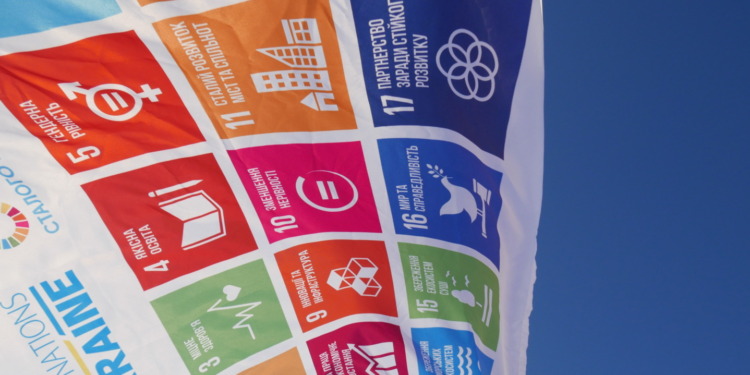Globally, on average, only 16% of the United Nations’ Sustainable Development Goals (SDGs) are on track to be met by 2030, according to the Sustainable Development Report 2024. The remaining 84% demonstrated either limited progress or a reversal in progress. The report states that this illustrates a stagnation in progress since 2020.
Particularly off track were the goals of Zero Hunger (SDG 2), Sustainable Cities and Communities (SDG 11), Life Below Water (SDG 14), Life on Land (SDG 15) and Peace, Justice and Strong Institutions (SDG 16). The five targets which show the largest reversal of progress since 2015 are: obesity rate, press freedom, sustainable nitrogen management, and life expectancy at birth — although this was skewed by the COVID-19 pandemic among other factors. All these targets are related to the off-track goals listed above.
The Sustainable Development Report 2024 is a global edition of a report released by the Sustainable Development Solutions Network (SDSN), an initiative for the United Nations. The report, released Monday, June 17th, provides the most up-to-date data which tracks and ranks UN member states’ performances in relation to the SDGs. The Sustainable Development Goals, adopted in 2015, consist of 17 goals and 169 targets aimed towards ensuring human well-being, socio-economic prosperity and environmental preservation.
In response to the bleak outlook of the SDGs as stated in the report, Professor Jeffrey D. Sachs, lead author of the report, said: “[T]he international community must take stock of the vital accomplishments and the limitations of the United Nations system, and work toward upgrading.”
One of the main findings of the report was that the pace of progress in achieving the SDGs vary by country and country groups. Nordic countries, for example, continue to lead the world in SDG achievement. Finland, Sweden and Denmark are ranked first, second and third, respectively, in the 2024 SDG Index. Germany and France round out the top five. BRICS countries — Brazil, Russia, India, China and South Africa — have outpaced the world average in SDG goal attainment since 2015, along with BRICS+ countries. However, East and South Asia is the region with the greatest progress towards SDGs since their inception.
These regions’ performances are in stark contrast with the poorest and least developed countries in the world, whose SDG progress lags far behind. The gap between the highest achievers, and the lowest achievers — namely the Small Island Developing States (SIDS) — grows wider by the year.
At the heart of this gap is the inability for developing nations to adequately fund their sustainable investments. According to the report, reforming the global financial architecture in order to ensure that every nation-state is able to achieve the SDGs is an urgent priority. Low-income countries need to gain access to long-term capital, financial and otherwise, to invest in sustainable development at a larger scale.
This would require more and more cooperation among UN member states. Additional multilateralism is key to collectively achieving the UN’s SDGs in the long-term, states the report. According to the new Index of support to UN-based multilateralism (UN-Mi), the five countries most committed to UN cooperation are: Barbados, Antigua and Barbuda, Uruguay, Mauritius and the Maldives. The least committed are: the United States, Somalia, South Sudan, Israel and North Korea. To be sure, this index concerns commitment to overall UN initiatives and engagement in the UN system, not simply a commitment to sustainable development.
Related Articles: A (Non) Modest Proposal for the G20: A Sustainable World Commission to Achieve the SDGs | All SDGs ‘Seriously Off Track,’ UN Report Finds | A Short History Of The SDGs | Maximizing Progress on the 2030 Agenda
The report also expresses particular concern for food and land systems around the world. The report states that by 2030, 600 million people will still suffer from hunger globally. In addition, obesity is increasing, and pollution from agriculture, forestry and other land use accounts for nearly 25% of total annual greenhouse gas emissions.
To combat what the SDSN has found to be a huge underachievement in the UN’s SDGs, the report argues for a revamping of the United Nations’ system. “We believe that the UN should be strengthened and empowered to underpin the new multi-polar world. Reforms include new UN bodies, such as a UN Parliament, new forms of global financing, and new strategies to ensure observance of international law and peace among the major powers. Ultimately, the UN Charter itself will need to be revised and updated to reflect our 21st century needs and realities,” states the 2024 edition of the report.
Without question, much needs to change within the UN and amongst individual member states to improve the rate at which sustainable development targets are attained. With less than one in six SDGs on track to be met by 2030, it goes without saying more investment and attention is needed by governments around the world. It remains to be seen whether this comes in the form of more multilateralism and foreign investments, or technological advancement, or simply a recommitment to these goals from almost 10 years ago.
Editor’s Note: The opinions expressed here by the authors are their own, not those of Impakter.com — In the Featured Photo: UN SDGs flag. Featured Photo Credit: UN Ukraine.








